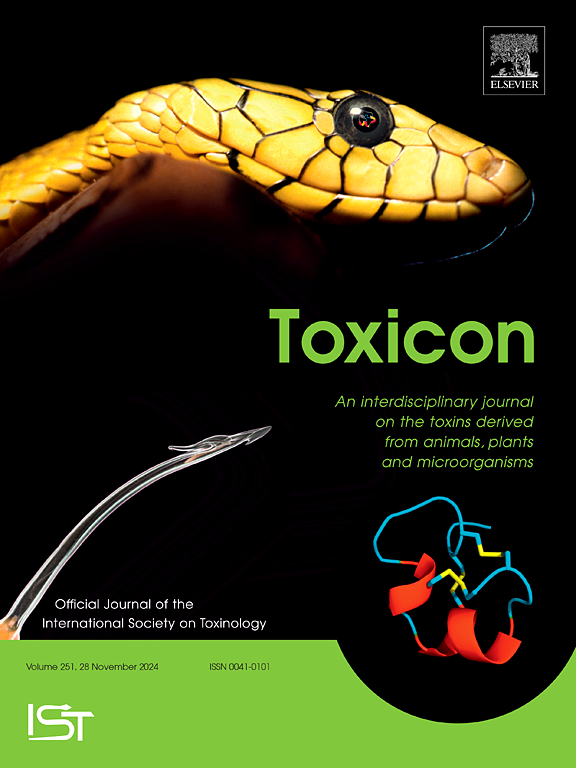Impact of environmental factors on Apis dorsata (giant Asian honeybee) venom in Bandarawela, Sri Lanka
IF 2.6
4区 医学
Q2 PHARMACOLOGY & PHARMACY
引用次数: 0
Abstract
Apis dorsata stings are amongst the most frequent insect-stings in Sri Lanka. A. dorsata venom consists of a mixture of components including PLA2, melittin, hyaluronidase and apamin. However, there are no studies done in Sri Lanka to evaluate the environmental influence in venom production. We, herein, tried to correlate the variations in those four venom components of A. dorsata with environmental factors (temperature, rainfall, wind speed and relative humidity). The venom components were analyzed using high-performance liquid chromatography (HPLC) and variations in environmental factors were gathered from the Department of Meteorology, Sri Lanka. Of the four components, PLA2 (r = 0.718; p = 0.009 and r = 0.636; p = 0.026) and melittin r = 0.734; p = 0.007 and r = 0.582; p = 0.047) showed significant correlations with temperature and wind speed, respectively. Whilst relative humidity showed significant negative correlations with PLA2 (r = - 0.634; p = 0.027) and melittin (r = −0.643; p = 0.024). There was no significant correlation of climatic parameters with hyaluronidase or apamin. The results indicated a variation in the composition of venom components with the month in which the venom was collected due to climatic influence and it should be considered when therapeutic grade venom preparations are produced.

环境因素对斯里兰卡班达拉韦拉亚洲大蜜蜂毒液的影响。
背蜂蜇伤是斯里兰卡最常见的昆虫蜇伤之一。多刺猿毒液由多种成分混合而成,包括PLA2、melittin、透明质酸酶和apamin。然而,在斯里兰卡还没有研究评估环境对毒液产生的影响。在此,我们试图将背甲蜥的这四种毒液成分的变化与环境因素(温度、降雨量、风速和相对湿度)联系起来。我们使用高效液相色谱法(HPLC)对毒液成分进行了分析,并从斯里兰卡气象局收集了环境因素的变化情况。在四种成分中,PLA2(r = 0.718; p = 0.009 和 r = 0.636; p = 0.026)和 melittin r = 0.734; p = 0.007 和 r = 0.582; p = 0.047)分别与温度和风速呈显著相关。相对湿度与 PLA2(r = - 0.634;p = 0.027)和 Melittin(r = -0.643;p = 0.024)呈显著负相关。气候参数与透明质酸酶或 apamin 没有明显的相关性。结果表明,受气候影响,毒液成分随采集毒液的月份而变化,在生产治疗级毒液制剂时应考虑到这一点。
本文章由计算机程序翻译,如有差异,请以英文原文为准。
求助全文
约1分钟内获得全文
求助全文
来源期刊

Toxicon
医学-毒理学
CiteScore
4.80
自引率
10.70%
发文量
358
审稿时长
68 days
期刊介绍:
Toxicon has an open access mirror Toxicon: X, sharing the same aims and scope, editorial team, submission system and rigorous peer review. An introductory offer Toxicon: X - full waiver of the Open Access fee.
Toxicon''s "aims and scope" are to publish:
-articles containing the results of original research on problems related to toxins derived from animals, plants and microorganisms
-papers on novel findings related to the chemical, pharmacological, toxicological, and immunological properties of natural toxins
-molecular biological studies of toxins and other genes from poisonous and venomous organisms that advance understanding of the role or function of toxins
-clinical observations on poisoning and envenoming where a new therapeutic principle has been proposed or a decidedly superior clinical result has been obtained.
-material on the use of toxins as tools in studying biological processes and material on subjects related to venom and antivenom problems.
-articles on the translational application of toxins, for example as drugs and insecticides
-epidemiological studies on envenoming or poisoning, so long as they highlight a previously unrecognised medical problem or provide insight into the prevention or medical treatment of envenoming or poisoning. Retrospective surveys of hospital records, especially those lacking species identification, will not be considered for publication. Properly designed prospective community-based surveys are strongly encouraged.
-articles describing well-known activities of venoms, such as antibacterial, anticancer, and analgesic activities of arachnid venoms, without any attempt to define the mechanism of action or purify the active component, will not be considered for publication in Toxicon.
-review articles on problems related to toxinology.
To encourage the exchange of ideas, sections of the journal may be devoted to Short Communications, Letters to the Editor and activities of the affiliated societies.
 求助内容:
求助内容: 应助结果提醒方式:
应助结果提醒方式:


